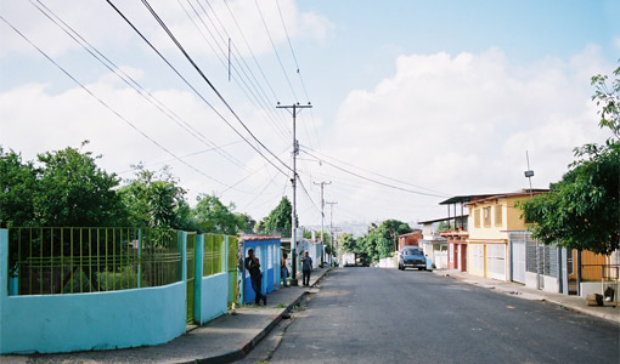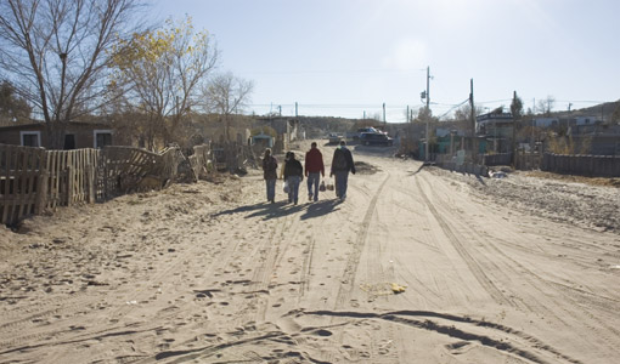There often is discussion at St. Thomas about how we can better prepare students to both engage in service to others, and to acknowledge the broad and complex world that awaits them upon graduation. It is a heady goal that echoes throughout classroom lectures, administrative objectives and casual conversations on the quad.
While the practical application can be elusive, there are meaningful signs that St. Thomas students recognize the value in this goal. St. Thomas study-abroad programs send more than 800 students out into the world each year, and service-learning projects provide students a chance to engage with local and international communities. But perhaps the most salient opportunities are found in the Volunteers in Service Internationally or Nationally (VISION) trips offered each January Term and spring break through Campus Ministry.
The first volunteer trip in 1987 was offered as part of a Liberation Theology course. Sixteen students accompanied Father Steve Garrigan to a New Ulm mission site in San Lucas Toliman, Guatemala. The students arrived to find a town ravaged by generational poverty. A handful of wealthy families owned most of the fertile coffee-growing land in the country, which left the people of San Lucas little hope of prosperity.
Around the same time, Brother Bill Clarey, director of counseling services, was being encouraged by St. Thomas President Monsignor Terrence Murphy to establish a full-time volunteer opportunity with an English-speaking country. Murphy wanted to make sure there were service opportunities for students who did not speak a second language. Clarey, a Christian Brother, helped to forge a relationship with Above Rocks, Jamaica, just one year before the country endured a direct hit by Hurricane Gilbert. The hurricane, the strongest to hit Jamaica in nearly 40 years, caused massive damage to the island. Shortly after the destruction, a group of St. Thomas students and Father John Forliti went down to help the Jamaican government rebuild.
Students experienced firsthand the long-term effects of poverty. They helped to paint and stabilize walls of what should have been temporary housing. But more than that, students built relationships with communitymembers and each other. The students returned to St. Thomas eager to get their friends involved, and to find new opportunities to affect positive social change.
Jamie McDonell ’94 M.A. was a Campus Ministry staff leader on that first trip. He had returned to Minnesota after a long-term, post-college volunteering stint in Appalachia. While speaking to a friend about his experience, McDonell lamented that many of his classmates had considered joining the Peace Corps after graduation, but very few of them followed through. “Companies were eager to be on campus to recruit new graduates, but there weren’t many full-time volunteer service representatives to talk to,” McDonell said.
Then during spring break 1987, McDonell led a group of students to work at the Amate House, a homeless shelter in a tough Chicago neighborhood. The intent of the trip was to provide a meaningful service experience for a small group of students,and also to help them determine whether or not they were interested in full-time volunteer work after graduation.
The St. Thomas students met before the trip to determine what personal items they would need to bring. It was decided that only the basics were appropriate – a book, a few cassettes and a change of clothes – and that the group would share other items such as a camera. The trip was a success, and the group discussion of what modern conveniences are appropriate to pack on a VISION trip remains an important part of the planning process.
Ironically, McDonell and the students found that there was a similar service trip bringing students from Kentucky to work in inner-city Minneapolis around the same time as the St. Thomas trip to Chicago. “There weren’t many service trips available to college students at that time,” McDonell said. “So, it was reaffirming to hear about the students coming to Minnesota. And for the rest of our trip, we speculated that somewhere there must be a van of student volunteers from Chicago headed to Kentucky.”
Together, Clarey and McDonell drafted a proposal for a fulltime volunteer coordinator position at the college. The proposal was accepted, and in 1989 VISION become an officially recognized program at St. Thomas.
Mike Klein ’90, ’98 M.A., served as director of the VISION program from 1994-2003, guiding the program as it grew from a few volunteer opportunities to a high point in 2000-2001 when 21 trips were offered, including a faculty-staff trip, an alumni trip, and a student-leadership training trip with more than 200 participants.
“The early 1990's saw a rising tide of volunteerism nationwide, and a growing passion for intercultural experiences,” Klein recalled. “St. Thomas students would line up overnight outside the Volunteer Center (now the Center for Community Partnerships), and often every trip would be filled within the first 20 minutes. It felt more like the box office at a rock concert than a volunteer program.”
VISION programs tapped into a desire by students to deepen their experience in the world. “The trips created space for spiritual and religious reflection” Klein said. Participants craved “sufficiency and simple living, a sense of community with peers and the community they served, and an opportunity to examine social justice issues through their volunteer work.”
The strength of VISION is often the lasting impact it has on leaders, participants and the community. After helping others in such dire conditions, VISION participants understandably could return home overwhelmed and saddened by the state of the world. Instead, many embrace optimism.
“I came to understand a great deal about overwhelming poverty and inspired solutions, racism and healing, white privilege and solidarity, but most of all, hope,” Klein said. “Beyond all the issues that surrounded us on VISION trips, the overwhelming theme was hope.
"Every St. Thomas participant and each community we visited offered a profound sense that we can work together, we can do better, and that no social problem is more powerful than the love of people committed to shared work and positive change. My daughter was born during my tenure with VISION, and each trip gave me hope that the world of her future would be a better place than the one of her birth.”
To date, more than 2,500 St. Thomas students, faculty and staff have participated in VISION trips. They have traveled to and worked together in such diverse locations as the White Earth Reservation in northern Minnesota; Selma, Ala.; Quito, Ecuador; New Orleans; and Alamosa, Colo.
Although the destinations may be distinct, all VISION trips are centered on six basic components: service, spirituality, justice issues, community, cultural exchange and simplicity. These components serve as the core of the VISION experience. Evening reflections often begin by discussing how a specific component is present in the service work performed during the day or through relationships students have developed within the community and with each other.
Each trip also has an experienced student leader. They are familiar with how group dynamics evolve during a trip, and what physical and emotional challenges may arise. Student leaders also are responsible for the group’s safety, but that is where the hierarchy ends. All group members – students, faculty or staff – are equals, and they work together to plan driving schedules, meal preparations and work assignments.
“Students do great when they own the experience,” said Jacob Cunningham ’99, who has served as coordinator of volunteer services in Campus Ministry since fall 2002. “These are not prepackaged trips. We really encourage students to bring their ideas to the group.”
The ownership that students have in planning a trip serves as yet another way to strengthen the shared experience and build community among group members. But should any group member get the idea that they are traveling to distant lands on a mission to teach others how to live their lives, Cunningham makes clear that “We do not come as saviors. We work in these communities to learn humility and open-mindedness. We are not here to pass judgment.”
VISION trips can offer a depth of experience that students don’t always find in the classroom. They apply for these trips with different ideas about the world they live in, and they leave having forged new relationships and a broadened perspective of the world community.
It was VISION’s emphasis on social justice that first caught the attention of Bob and Mary Jo Loftus. As adults, the couple sought out lectures at St. Thomas that focused on theology and social justice issues. When they sold their home-care business in 1999, the Loftuses decided to help fund organizations that empowered students and young adults to serve the global community. The family discovered the VISION program while their second son, Joe Loftus ’03, was a student at St. Thomas.
“Over the years, we’ve had a chance to broaden our view of the world by traveling abroad,” said Bob Loftus. “The VISION program invites students to not just travel, but to live and serve in communities that are often on the margins of society. In return, students represent St. Thomas through their generosity, creativity and the building of relationships.”
As a family, the Loftuses decided to endow the VISION program to ensure that future St. Thomas students will have the chance to experience and learn from these trips for years to come. “Attending college is about more than IQ achievement,” said Loftus. “A student must develop as a whole person – whether they are studying theology or business. Part of that growth is to become aware of the social justice issues that affect the world around us.”
“Students continue to seek out new opportunities to serve others,” Cunningham said. “There have been requests for VISION trips to address AIDS issues in Africa, war recovery in Bosnia and health care issues in our own country. There is still so much healing that needs to take place in our world.”
Editor’s note: To get a better understanding of the impact these trips can have on both the students and the communities they serve, St. Thomas magazine sent writers and photographers on four VISION trips in January 2007 – Belfast, Northern Ireland; San Lucas Toliman, Guatemala; Juarez, Mexico; and Puerto Ordaz, Venezuela. As you will read throughout the magazine, the experiences vary from painting a mural on a Belfast wall to picking coffee fruit in Guatemala to learning about immigration issues along the Mexican border. The final feature offers a reflection on a journey through VISION trips by Jane Tigan ’07.







